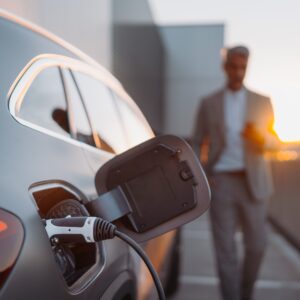
Insights
Ready or Not, EV Adoption Is Accelerating Even Faster than Expected

Is the US ready for electric vehicles? It’s been a matter of debate for some time, and there are plenty of skeptics across multiple sectors, including convenience retail. However, it’s becoming increasingly difficult to ignore the writing on the wall with the growing number of EVs on the road.
If you’re still not convinced, consider this: According to a Gallup News Service press release dated April 26, 2000, about a quarter of all Americans claimed they would never own a cell phone. Fast forward 23 years, and cell phone ownership among adults in the U.S. is hovering near 100% with most users going all in on smartphones.
Will EV adoption happen just as fast or faster? Maybe. The most telling piece of the EV adoption story is how market projections are revised year after year because the transition is happening faster than most industry experts predicted. According to EV adoption research by Recurrent, a company that helps people buy and sell used electric cars, “In the course of 4 years – from 2018 to 2022 – US EV sales projections for 2030 more than doubled, growing from an estimated 21% to 53%.”
The convenience industry can’t afford to be caught asleep at the wheel.
Clearly, convenience stores need to start preparing now for what will surely be a rapid and ongoing proliferation of electric vehicles on the roads, and sooner than later. Here are four key reasons to get your EV strategy revved up ASAP:
1) Trends indicate that the US is on the cusp of a significant uptick in adoption. Compared to other countries, and European nations like Norway in particular, the US is considered at the very early stages of EV adoption. In the states, innovators and early adopters are driving the majority of EV sales right now. However, EV sales projections for the next several years show that more and more consumers are planning to make the switch.
Furthermore, trends from other countries ahead of the US on the EV journey show that when the majority buys in, they do so rapidly. And some states are getting very close to that tipping point. While a recent report from CarEdge shows 7.9% market share for fully-electric vehicle sales across the U.S. for Q3 2023, the Office of California Governor Gavin Newsome reported that EVs accounted for 25.4% of all new cars sold in California in in the second quarter of 2023. As individual states, and the country as a whole, continue to post record increases and all-time highs, the U.S. is likely to see a rapid uptick in adoption soon.
Reports of a slowdown in growth, and adjustments by several OEM’s to EV production forecasts, may be creating some concern for stakeholders, but this is expected and typical of any technology focused adoption curve where a chasm exits and must be crossed between the early adopters and the early majority.

2) NEVI Formula funding will usher in more and better infrastructure. Even if you know a lot of holdouts or families who say they will continue to keep at least one Internal Combustion Engine (ICE) vehicle indefinitely for long-range trips, the reality is that it’s not a lack of consumer enthusiasm for EVs that is holding back adoption trends. Instead, it’s the infrastructure—or lack thereof—that’s the problem. Worries about the availability of chargers, the speed of those chargers, and reports about charger downtime have some drivers concerned about whether they will be able to complete their trips or if they will have to plan their routes around availability of charging stations.
But that’s quickly changing, too. While the home remains the main source of charging today among the early adopter segment, public infrastructure will continue to grow and improve, which in turn will further steepen the adoption curve.
The National Electric Vehicle Infrastructure Formula Program (NEVI Formula) has already started playing a large role here by providing funding “to strategically deploy EV charging infrastructure and to establish an interconnected national network to facilitate station data collection, access, and reliability.” The goal of NEVI Formula is to create a network of Alternative Fuel Corridors (AFCs) in every state “with DC fast chargers every 50 miles and within 1 mile of the corridor.” Convenience retailers will have opportunities to access and use program funds to acquire, install, operate, and maintain EV charging stations as long as the funded project meets the EV Charging Minimum Standards Rule.
3) OEMs have more and more skin in the game. While Tesla is considered the clear leader in EVs as well as the charging infrastructure to support them, other major Original Equipment Manufacturers (OEMs) including Ford and General Motors are making strides to catch up. Several OEMs have made recent announcements about transitioning from ICE vehicles to producing more EVs, with some phasing out of ICE production altogether. This means that OEMs have a major stake in driving EV adoption, and several are committing to helping with expanding charging infrastructure and supporting charger installation, not just at their own dealership sites, but across the board.
We’re also seeing more collaboration among the players that will help advance the industry. Ford and GM have both announced partnerships with Tesla that will allow drivers of their EV models to use Tesla charging infrastructure—previously accessible to Tesla drivers only, which is renowned as some of the best and most widely available in the country. These partnerships will allow Tesla to create a public network and ensure its own access to NEVI Formula funding while giving more EV owners of all makes and models greater access to existing high-quality charging options.
4) Regulatory policies and new incentives are driving more converts. In some places, regulations will force the transition to EVs, while in other cases, financial incentives will win over the holdouts. California’s high adoption rates are driven in large part by clean energy legislation mandating that all new cars in the state be zero emission by 2035. But the Golden State isn’t the only region taking action.
According to a CBS News Bay Area article from September 2022, Washington, Massachusetts, New York, Oregon, and Vermont will likely follow California’s example and adopt the state’s strict rules soon. Other states are looking at their own programs to advance EV adoption. In addition, many states are offering tax and electrical cost incentives to entice consumers and help build a stronger financial case for the switch to EVs.
It’s time to move your EV strategy into the fast lane.
A future in which convenience retail sites will be built without gas pumps may still be several decades away. But with more and more players getting into the game, EV trends are not going to slow down. Convenience retailers need to embrace the reality and start thinking through what it means for their businesses. Stay tuned for our next post on Making Your EV Game Plan for some ideas that can help jump start the conversation.
Related Insights
Navigating the Future of Electric Vehicles Amidst Administrative Change
As we bid farewell to 2024 and welcome 2025, the future of the electric vehicle (EV) market in the US […]
The Changing Role of the CIO
It used to be that a retailer’s chief information officer would spend most of his or her time concerned with […]
Maximize Category Margins – Part 1: Overcoming Challenges Amid Rising Costs
The flood of escalating costs has been an ongoing challenge for retailers. Though balancing the protection of category margins while […]
Is Tesla the New Oil Major?
A Leader Amongst Followers When we hear the name Tesla, right or wrong, we immediately think about the brand that […]
Want to stay in touch? Subscribe to the Newsletter






